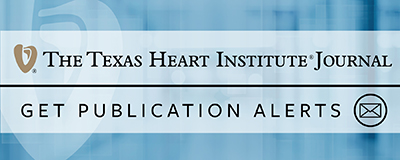Double Atrial Septum With Interatrial Space in Patients Experiencing Ischemic Attack
Case Description
Case 1
A 66-year-old man with a transient neurologic deficit was admitted to the Department of Neurology. Computed tomography and magnetic resonance imaging identified 2 cerebral ischemic lesions in the left frontal lobe. His medical history indicated type 2 diabetes and elevated blood lipid levels. A 12-lead electrocardiogram and a 24-hour Holter monitor revealed sinus rhythm.
Transesophageal echocardiography showed an accessory membrane lying parallel to the interatrial septum to communicate freely with the left atrium (Fig. 1). Color Doppler echocardiography and agitated saline infusion excluded the presence of a patent foramen ovale. No clot was visualized within the double interatrial cavity or left atrium.


Citation: Texas Heart Institute Journal 52, 1; 10.14503/THIJ-24-8515
Case 2
A 78-year-old man was hospitalized after an ischemic stroke. Computed tomography and magnetic resonance imaging identified an ischemic lesion with M2 segment occlusion of the middle cerebral artery. His medical history indicated hypertension and elevated blood lipid levels. A 12-lead electrocardiogram and a 24-hour Holter monitor revealed sinus rhythm.
Transesophageal echocardiography showed a double interatrial septum without thrombus within the double interatrial cavity or left atrium (Fig. 2).


Citation: Texas Heart Institute Journal 52, 1; 10.14503/THIJ-24-8515
Comment
Double interatrial septum is a rare anomaly in the medical literature.1 The etiology of a double interatrial septum is not clear. According to Roberson,1 the accessory septal structure in the left atrium may be an abnormality of the atrial primum septum. Although the majority of patients are asymptomatic, paradoxical embolism is a common clinical manifestation of this anomaly.
Double interatrial septum has been called a source of thromboembolism, including cerebral infarctions.2,3 The double interatrial cavity creates a low-flow state that increases the risk of thrombus formation and thromboembolic events. Treatment for these patients may include surgical correction, antithrombotic drugs, or anticoagulation, but a standard approach has yet to be established. Therapy with aspirin and clopidogrel is suggested based on finding from the Platelet-Oriented Inhibition in New TIA and Minor Ischemic Stroke (POINT) trial.4
The patients in case 1 and case 2 were discharged home. After follow-up visits, they have remained asymptomatic.

Transesophageal echocardiogram of the patient in case 1 shows a double atrial septum that communicates freely with the left atrium.

Transesophageal echocardiogram of the patient in case 2 shows a double atrial septum with persistent interatrial space.
Contributor Notes
